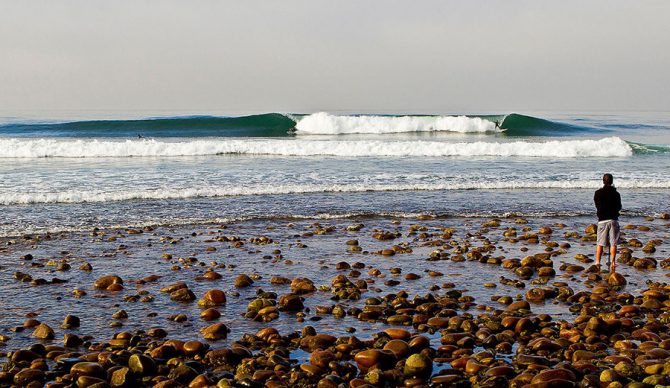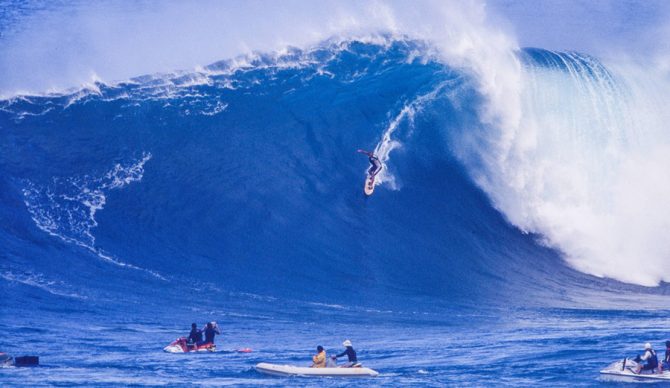
Pipeline looks beautiful. But the terror lies beneath (and in the lineup). Photo: Ryan “Chachi” Craig
This winter season on Oahu’s North Shore and, more specifically, the Banzai Pipeline, has seen an unprecedented spate of serious players being taken out by serious surfing accidents. Within weeks a handful of certified hellmen, including Joao Chianca, Koa Rothman, Eimeo Czermak, Joaquin Del Castillo and even the previously invulnerable Kai Lenny, exited Pipe’s strenuous stage with grievous injuries, several even requiring life-saving CPR, and others varying from battered heads and helmets to shattered hips and more stitches than we care to count.
A terrible pattern, to be sure, but not as troubling, in my mind, as a sixth surfer who was also pulled unconscious from the Pipeline shorbreak and revived by the world’s best lifeguards. A surfer who, far from being a stickered pro, was apparently a novice, completely unqualified to paddle out, but lured, undoubtedly, to the Pipeline lineup by patently misleading information provided by various surf forecasting entities and surf tabloid sites who repeatedly use adjectives like “perfect” and “proper” to describe fearsome big days at the world’s deadliest surf spot. Not to mention the aforementioned authorities’ custom of cutting wave size by half, and in some cases even by two-thirds, when depicting heavy surf, not only at Pipeline, but at many other “black diamond” breaks around the world. This groundswell of misinformation is precisely why I’d like to suggest that surfing establish a grading system, like that used by its sister sport of rock climbing.
Yeah, sister sport. Think: vertical walls, culture clashes between”trad” and sport participants, and Patagonia’s Ventura Point headquarters. But for those unfamiliar with the pursuit, since roughly 1937 the sport has been assigning a number to each vertical route, this “grade” designating a particular climb’s potential for both difficulty and danger. These grades start (for some inexplicable reason) at 5.1, meaning a low difficulty/danger quotient, and go all the way up to the sport’s most hairy climbs, with grades as high as 5.15. For good measure (get it?), since the introduction of the Yosemite Decimal Scale in the 1950s, each grade has received exponentially more arduous a, b, c or d’s attached, so as to really get granular when informing climbers what they’re getting themselves into. In 2023, for example, Austrian climber Jakob Schuburt completed a route in Norway, considered one of the world’s most difficult, earning the otherworldly grade of 5.15d
The interesting thing, however, is that these grades aren’t established by any official sanctioning body, but arbitrarily decided upon by those daring souls who first complete the climb, then to be confirmed or modified by those who come after. Modifications can have serious consequences as they almost always result in a downgrade. Some years back a talented young British climber completed a route to which he assigned the lofty European grade of E12. It was quickly repeated by a respected older rock star who subsequently leveled a rare “triple downgrade,” and in the face of particularly virulent disapprobation from the British climbing community the young upstart fled to mainland Europe, where he lived and continued to climb in exile for the next 15 years. I really feel for the guy: can you imagine assigning a grade to your coastline’s gnarliest local slab, and then have Nathan Florence show up?
In any case, I think a surfing grading system would not only make the sport a whole lot safer, but a lot more fun to watch. So leaving myself wide open for vitriol, I’ll provide, as examples, a few grades of my own. Considering how I began this story, I’ll start with the Pipeline complex. Feel free to “conform or modify” throughout.
Pipeline: 5.15c
In terms of difficulty the wave is a beast, but the real challenge is actually catching one. Unless you’re an elite-level surfer, or born and raised in the 96712-17 area code, or have the last name Ho, you have absolutely zero chance of catching and successfully riding a wave at Pipeline. Less, even. Danger-wise, as mentioned it’s statistically the most dangerous surf spot in any ocean, and is apparently getting even more so.

JOB Surfing backdoor likes it’s his job.
Backdoor: 5.15b
See all of the above. Its single letter downgrade reflects that fact that good Backdoor waves are generally smaller and less-contested than Pipe’s front door. Then again, it closes out onto a horribly shallow lava reef, not the Ehukai Sandbar, so go ahead and bump the grade up if you’re feeling confident.

Macaronis, looking ripe.
Macaronis: 5.9
This left reef break in the Mentawais is so uniform, peeling so dutifully to the contours of it coral configuration, and at such measured, predictable speed, that once you get to your feet it’s almost hard to fall – it literally squeezes you to the shoulder. If you do happen to go down, however, you will inevitably bounce on said coral bottom, a circumstance that keeps its grade from going lower.

Ireland is not a place for the surfer who lusts after warm water.
Mullaghmore: 5.14d
This is a tough one. On one hand, the wave is scary hollow, brutally cold and, at 30 to 40 foot, as gnarly as just about any spot you care to mention. On the other hand, so few surfers besides a few hardy British Isle hellmen and occasional fully-insulated visiting pros seem to want anything to do with this Celtic monster, that the takeoff spot appears wide open to all challengers. Also, the Irish Tow Surf Rescue Club is full-on Top Gun, lowering the grade méid beag, as the boyos would put it.

Lowers, again. Photo: WSL
Lower Trestle: 5.5
Which, by rock climbing comparison, means a stroll in the park, more fun than potentially fatal. For a premier spot, the wave itself is one of the easiest to surf, and surf well. But the fact that if you can’t afford an expensive e-bike there’s a long, hot walk in (and out), plus the veritable salmon spawn of surfboards to be negotiated in the lineup on anything resembling a swell, jacks the grade up a bit. Down-gradable, however, if you ride a Mayhem.

Early test pilot Laird Hamilton, breaking all sorts of barriers at Peahi, mid-90s. Photo: Tom Servais.
Peahi: 5.13b
Only 5.13b? Yes, it’s tall, and yes, it’s thick and yes, it barrels like Stockton Avenue on steroids. But c’mon, how can you stack a spot that was surfed back in 2021 by 11 year-old “Baby” Steve Roberson, who this season at age 14 took one of the worst wipeouts of the year, commenting afterward, “When I came up I just felt so alive…,” against potentially deadly spots like Maverick’s, Nazaré and that crazy Westside wave Mason Ho surfs?

Mikey Wright: right place, right time. Photo: screenshot
Snapper Rocks: 5.10d
At head-high, this dredging, sand-bottom peeler is the sort of wave most surfers dream of riding. Operative word: dream. In reality, Snapper has, per capita, the most talented, world-titled pack of locals around, a really tricky take-off, the world’s craziest mob…and that’s just the difficulty part. The danger is putting oneself in the position to be cursed at for dropping in on Stephanie Gilmore, by Stephanie Gilmore.

Yeah, it’s that shallow. Photo: Ho & Pringle Productions
Not 3rd Dip: Off-the-Scale
Speaking of Mason Ho, the fact that he and wingman Sheldon Paishon haven’t yet required extensive reconstructive surgery and months in traction belies the fact that this off-limits (to the rest of us) Westside Oahu wave isn’t a surf spot by any reasonable surfer’s standard, but merely a random, albeit pretty, surge pouring over damp coral. That these two survive their attempts in such spectacular fashion [read: actually coming out of a barrel now and then] almost earns this “not-actually-a-spot” an actual grade…but not quite.

